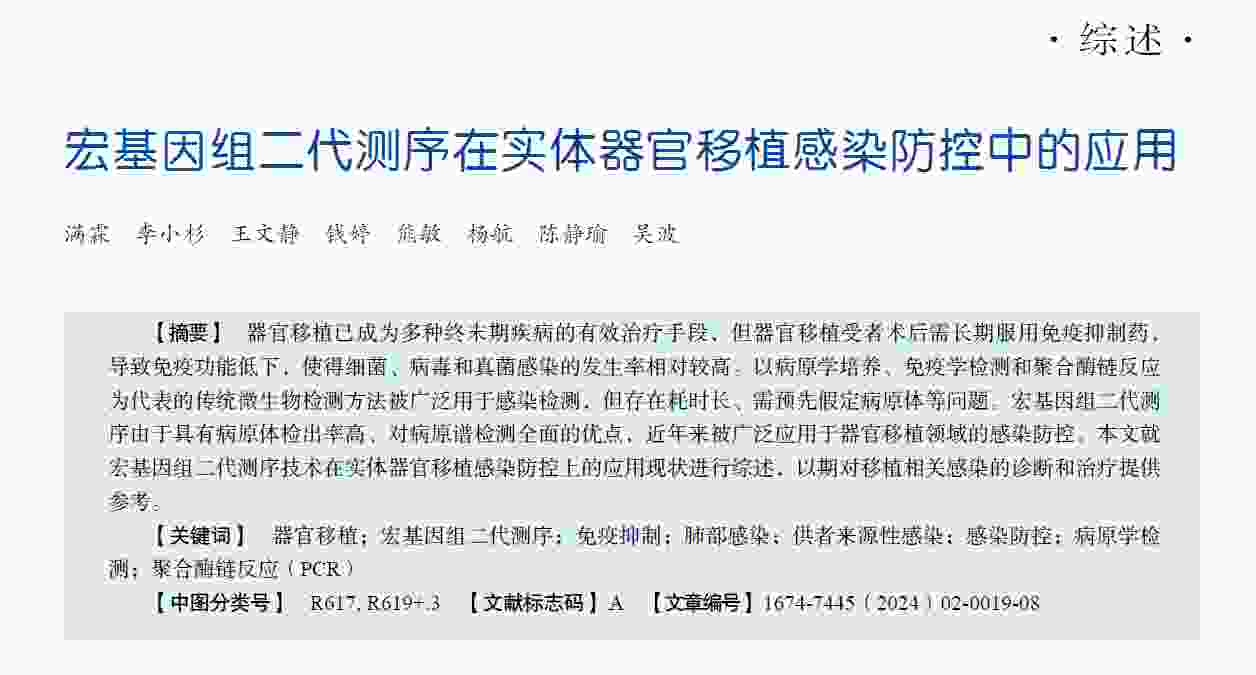| [1] |
KUMAR R, ISON MG. Opportunistic infections in transplant patients[J]. Infect Dis Clin North Am, 2019, 33(4): 1143-1157. DOI: 10.1016/j.idc.2019.05.008.
|
| [2] |
MAGDA G. Opportunistic infections post-lung transplantation: viral, fungal, and mycobacterial[J]. Clin Chest Med, 2023, 44(1): 159-177. DOI: 10.1016/j.ccm.2022.10.012.
|
| [3] |
LIU D, ZHANG J, WU B, et al. Impact of donor lung colonized bacteria detected by next-generation sequencing on early post-transplant outcomes in lung transplant recipients[J]. BMC Infect Dis, 2020, 20(1): 689. DOI: 10.1186/s12879-020-05393-w.
|
| [4] |
CHIU CY, MILLER SA. Clinical metagenomics[J]. Nat Rev Genet, 2019, 20(6): 341-355. DOI: 10.1038/s41576-019-0113-7.
|
| [5] |
GOPALAKRISHNAN V, AGARWAL SK, AGGARWAL S, et al. Infection is the chief cause of mortality and non-death censored graft loss in the first year after renal transplantation in a resource limited population: a single centre study[J]. Nephrology (Carlton), 2019, 24(4): 456-463. DOI: 10.1111/nep.13401.
|
| [6] |
KOSMADAKIS G, DAIKOS GL, PAVLOPOULOU ID, et al. Infectious complications in the first year post renal transplantation[J]. Transplant Proc, 2013, 45(4): 1579-1583. DOI: 10.1016/j.transproceed.2012.10.047.
|
| [7] |
吴小霞, 吴灵俐, 万齐全. 肝移植术后早期细菌与真菌感染病原体分布及危险因素[J]. 中南大学学报(医学版), 2022, 47(8): 1120-1128. DOI: 10.11817/j.issn.1672-7347.2022.220054.WU XX, WU LL, WAN QQ. Pathogen distribution and risk factors of bacterial and fungal infections after liver transplantation[J]. J Cent South Univ(Med Sci), 2022, 47(8): 1120-1128. DOI: 10.11817/j.issn.1672-7347.2022.220054.
|
| [8] |
VAN DELDEN C, STAMPF S, HIRSCH HH, et al. Burden and timeline of infectious diseases in the first year after solid organ transplantation in the Swiss transplant cohort study[J]. Clin Infect Dis, 2020, 71(7): e159-e169. DOI: 10.1093/cid/ciz1113.
|
| [9] |
钟振锋, 荣丽娟, 陈艳红, 等. 器官移植患者术后医院感染的影响因素[J]. 中华医院感染学杂志, 2020, 30(20): 3113-3116. DOI: 10.11816/cn.ni.2020-193145.ZHONG ZF, RONG LJ, CHEN YH, et al. Influencing factors for nosocomial infection in patients after organ transplantation[J]. Chin J Nosocomiol, 2020, 30(20): 3113-3116. DOI: 10.11816/cn.ni.2020-193145.
|
| [10] |
KREITMANN L, GAUDET A, NSEIR S. Ventilator-associated pneumonia in immunosuppressed patients[J]. Antibiotics (Basel), 2023, 12(2): 413. DOI: 10.3390/antibiotics12020413.
|
| [11] |
DUNN DL. Gram-negative bacterial sepsis and sepsis syndrome[J]. Surg Clin North Am, 1994, 74(3): 621-635. DOI: 10.1016/S0039-6109(16)46333-4.
|
| [12] |
MØLLER DL, SØRENSEN SS, PERCH M, et al. Bacterial and fungal bloodstream infections in solid organ transplant recipients: results from a Danish cohort with nationwide follow-up[J]. Clin Microbiol Infect, 2022, 28(3): 391-397. DOI: 10.1016/j.cmi.2021.07.021.
|
| [13] |
LA HOZ RM, LIU T, XIE D, et al. The use of automated data extraction tools to develop a solid organ transplant registry: proof of concept study of bloodstream infections[J]. J Infect, 2021, 82(1): 41-47. DOI: 10.1016/j.jinf.2020.10.003.
|
| [14] |
HERRERA S, MORATA L, SEMPERE A, et al. Pseudomonas aeruginosa bloodstream infection, resistance, and mortality: do solid organ transplant recipients do better or worse?[J]. Antibiotics (Basel), 2023, 12(2): 380. DOI: 10.3390/antibiotics12020380.
|
| [15] |
ZHU Y, ZHANG X, WANG Y, et al. Insight into carbapenem resistance and virulence of Acinetobacter baumannii from a children's medical centre in eastern China[J]. Ann Clin Microbiol Antimicrob, 2022, 21(1): 47. DOI: 10.1186/s12941-022-00536-0.
|
| [16] |
FISHMAN JA. Infection in organ transplantation[J]. Am J Transplant, 2017, 17(4): 856-879. DOI: 10.1111/ajt.14208.
|
| [17] |
DI PASQUALE MF, SOTGIU G, GRAMEGNA A, et al. Prevalence and etiology of community-acquired pneumonia in immunocompromised patients[J]. Clin Infect Dis, 2019, 68(9): 1482-1493. DOI: 10.1093/cid/ciy723.
|
| [18] |
MIAO Q, MA Y, WANG Q, et al. Microbiological diagnostic performance of metagenomic next-generation sequencing when applied to clinical practice[J]. Clin Infect Dis, 2018, 67(suppl_2): S231-S240. DOI: 10.1093/cid/ciy693.
|
| [19] |
ZHAO Z, SONG J, YANG C, et al. Prevalence of fungal and bacterial co-infection in pulmonary fungal infections: a metagenomic next generation sequencing-based study[J]. Front Cell Infect Microbiol, 2021, 11: 749905. DOI: 10.3389/fcimb.2021.749905.
|
| [20] |
ZILBERBERG MD, NATHANSON BH, SULHAM K, et al. Carbapenem resistance, inappropriate empiric treatment and outcomes among patients hospitalized with Enterobacteriaceae urinary tract infection, pneumonia and sepsis[J]. BMC Infect Dis, 2017, 17(1): 279. DOI: 10.1186/s12879-017-2383-z.
|
| [21] |
STRICH JR, HEIL EL, MASUR H. Considerations for empiric antimicrobial therapy in sepsis and septic shock in an era of antimicrobial resistance[J]. J Infect Dis, 2020, 222(Suppl 2): S119-S131. DOI: 10.1093/infdis/jiaa221.
|
| [22] |
KADRI SS, LAI YL, WARNER S, et al. Inappropriate empirical antibiotic therapy for bloodstream infections based on discordant in-vitro susceptibilities: a retrospective cohort analysis of prevalence, predictors, and mortality risk in US hospitals[J]. Lancet Infect Dis, 2021, 21(2): 241-251. DOI: 10.1016/S1473-3099(20)30477-1.
|
| [23] |
GU W, DENG X, LEE M, et al. Rapid pathogen detection by metagenomic next-generation sequencing of infected body fluids[J]. Nat Med, 2021, 27(1): 115-124. DOI: 10.1038/s41591-020-1105-z.
|
| [24] |
BLAUWKAMP TA, THAIR S, ROSEN MJ, et al. Analytical and clinical validation of a microbial cell-free DNA sequencing test for infectious disease[J]. Nat Microbiol, 2019, 4(4): 663-674. DOI: 10.1038/s41564-018-0349-6.
|
| [25] |
XU Y, LEWANDOWSKI K, DOWNS LO, et al. Nanopore metagenomic sequencing of influenza virus directly from respiratory samples: diagnosis, drug resistance and nosocomial transmission, United Kingdom, 2018/19 influenza season[J]. Euro Surveill, 2021, 26(27): 2000004. DOI: 10.2807/1560-7917.ES.2021.26.27.2000004.
|
| [26] |
CHEN T, ZHANG L, HUANG W, et al. Detection of pathogens and antimicrobial resistance genes in ventilator-associated pneumonia by metagenomic next-generation sequencing approach[J]. Infect Drug Resist, 2023, 16: 923-936. DOI: 10.2147/IDR.S397755.
|
| [27] |
FENOLLAR F, RAOULT D. Molecular diagnosis of bloodstream infections caused by non-cultivable bacteria[J]. Int J Antimicrob Agents, 2007, 30(Suppl 1): S7-S15. DOI: 10.1016/j.ijantimicag.2007.06.024.
|
| [28] |
BURGUETE SR, MASELLI DJ, FERNANDEZ JF, et al. Lung transplant infection[J]. Respirology, 2013, 18(1): 22-38. DOI: 10.1111/j.1440-1843.2012.02196.x.
|
| [29] |
CHEN H, YANG A, WU C, et al. Identification of a detection panel for post-transplant virus infection through integrated analysis of non-coding RNAs in peripheral blood[J]. Artif Cells Nanomed Biotechnol, 2021, 49(1): 691-698. DOI: 10.1080/21691401.2021.2011304.
|
| [30] |
KOTLA SK, KADAMBI PV, HENDRICKS AR, et al. BK polyomavirus-pathogen, paradigm and puzzle[J]. Nephrol Dial Transplant, 2021, 36(4): 587-593. DOI: 10.1093/ndt/gfz273.
|
| [31] |
BENNETT D, BERGANTINI L, FERRARA P, et al. Cytomegalovirus infection is associated with development of chronic lung allograft dysfunction[J]. Lung, 2022, 200(4): 513-522. DOI: 10.1007/s00408-022-00551-0.
|
| [32] |
PARIZE P, MUTH E, RICHAUD C, et al. Untargeted next-generation sequencing-based first-line diagnosis of infection in immunocompromised adults: a multicentre, blinded, prospective study[J]. Clin Microbiol Infect, 2017, 23(8): 574. e1-574. e6. DOI: 10.1016/j.cmi.2017.02.006.
|
| [33] |
XI Y, ZHOU J, LIN Z, et al. Patients with infectious diseases undergoing mechanical ventilation in the intensive care unit have better prognosis after receiving metagenomic next-generation sequencing assay[J]. Int J Infect Dis, 2022, 122: 959-969. DOI: 10.1016/j.ijid.2022.07.062.
|
| [34] |
PARASURAMAN R, SAMARAPUNGAVAN D, VENKAT KK. Updated principles and clinical caveats in the management of infection in renal transplant recipients[J]. Transplant Rev (Orlando), 2010, 24(2): 43-51. DOI: 10.1016/j.trre.2009.09.001.
|
| [35] |
BRUNE JE, DICKENMANN M, WEHMEIER C, et al. Swiss transplant cohort study. impact of different urinary tract infection phenotypes within the first year post-transplant on renal allograft outcomes[J]. Am J Transplant, 2022, 22(7): 1823-1833. DOI: 10.1111/ajt.17026.
|
| [36] |
VELIOGLU A, GUNERI G, ARIKAN H, et al. Incidence and risk factors for urinary tract infections in the first year after renal transplantation[J]. PLoS One, 2021, 16(5): e0251036. DOI: 10.1371/journal.pone.0251036.
|
| [37] |
HOLLYER I, ISON MG. The challenge of urinary tract infections in renal transplant recipients[J]. Transpl Infect Dis, 2018, 20(2): e12828. DOI: 10.1111/tid.12828.
|
| [38] |
DUAN W, YANG Y, ZHAO J, et al. Application of metagenomic next-generation sequencing in the diagnosis and treatment of recurrent urinary tract infection in kidney transplant recipients[J]. Front Public Health, 2022, 10: 901549. DOI: 10.3389/fpubh.2022.901549.
|
| [39] |
CHEN J, HE T, LI X, et al. Metagenomic next-generation sequencing in diagnosis of a case of pneumocystis jirovecii pneumonia in a kidney transplant recipient and literature review[J]. Infect Drug Resist, 2020, 13: 2829-2836. DOI: 10.2147/IDR.S257587.
|
| [40] |
JIANG J, BAI L, YANG W, et al. Metagenomic next-generation sequencing for the diagnosis of pneumocystis jirovecii pneumonia in non-HIV-infected patients: a retrospective study[J]. Infect Dis Ther, 2021, 10(3): 1733-1745. DOI: 10.1007/s40121-021-00482-y.
|
| [41] |
FOONG KS, MABAYOJE M, ALMAJALI A. Clinical impact of noninvasive plasma microbial cell-free deoxyribonucleic acid sequencing for the diagnosis and management of pneumocystis jirovecii pneumonia: a single-center retrospective study[J]. Open Forum Infect Dis, 2022, 9(12): ofac652. DOI: 10.1093/ofid/ofac652.
|
| [42] |
TIAN X, DUAN W, ZHANG X, et al. Metagenomic next-generation sequencing reveals the profile of viral infections in kidney transplant recipients during the COVID-19 pandemic[J]. Front Public Health, 2022, 10: 888064. DOI: 10.3389/fpubh.2022.888064.
|
| [43] |
ZHANG F, CHEN J, HUANG H, et al. Application of metagenomic next-generation sequencing in the diagnosis and treatment guidance of pneumocystis jirovecii pneumonia in renal transplant recipients[J]. Eur J Clin Microbiol Infect Dis, 2021, 40(9): 1933-1942. DOI: 10.1007/s10096-021-04254-x.
|
| [44] |
卢建军, 刘大钺, 李恒爱, 等. 肝移植术后感染影响因素的临床研究进展[J]. 中华医院感染学杂志, 2018, 28(24): 3836-3840. DOI: 10.11816/cn.ni.2018-186165.LU JJ, LIU DY, LI HA, et al. The clinical research progress on the risk factors of postoperative infections for patients after liver transplantation[J]. Chin J Nosocomiol, 2018, 28(24): 3836-3840. DOI: 10.11816/cn.ni.2018-186165.
|
| [45] |
ECHENIQUE IA, ISON MG. Update on donor-derived infections in liver transplantation[J]. Liver Transpl, 2013, 19(6): 575-585. DOI: 10.1002/lt.23640.
|
| [46] |
HUANG JF, MIAO Q, CHENG JW, et al. Metagenomic next-generation sequencing versus traditional laboratory methods for the diagnosis and treatment of infection in liver transplantation[J]. Front Cell Infect Microbiol, 2022, 12: 886359. DOI: 10.3389/fcimb.2022.886359.
|
| [47] |
PAREKH JR, GREENSTEIN S, SUDAN DL, et al. Beyond death and graft survival-variation in outcomes after liver transplant. results from the NSQIP transplant beta phase[J]. Am J Transplant, 2019, 19(7): 2108-2115. DOI: 10.1111/ajt.15357.
|
| [48] |
段飞, 李学民, 段希斌, 等. 腹部手术后手术部位感染的影响因素分析[J]. 中华消化外科杂志, 2022, 21(12): 1539-1546. DOI: 10.3760/cma.j.cn115610-20220920-00537.DUAN F, LI XM, DUAN XB, et al. Influencing factors of surgical site infection after abdominal surgery[J]. Chin J Dig Surg, 2022, 21(12): 1539-1546. DOI: 10.3760/cma.j.cn115610-20220920-00537.
|
| [49] |
NATOLI RM, MARINOS DP, MONTALVO RN, et al. Poor agreement between next-generation DNA sequencing and bacterial cultures in orthopaedic trauma procedures[J]. J Bone Joint Surg Am, 2022, 104(6): 497-503. DOI: 10.2106/JBJS.21.00785.
|
| [50] |
GU W, MILLER S, CHIU CY. Clinical metagenomic next-generation sequencing for pathogen detection[J]. Annu Rev Pathol, 2019, 14: 319-338. DOI: 10.1146/annurev-pathmechdis-012418-012751.
|
| [51] |
ZHANG N, MA L, DING W. The diagnostic value of blood next-generation sequencing in early surgical site infection after spine surgery[J]. Int J Gen Med, 2023, 16: 37-45. DOI: 10.2147/IJGM.S394255.
|
| [52] |
ZHAO D, GUO L, LIAN D, et al. Diagnostic value and clinical application of mngs for post-liver transplantation infection: a cross-sectional study with case reports[J]. Front Microbiol, 2022, 13: 919363. DOI: 10.3389/fmicb.2022.919363.
|
| [53] |
NOSOTTI M, TARSIA P, MORLACCHI LC. Infections after lung transplantation[J]. J Thorac Dis, 2018, 10(6): 3849-3868. DOI: 10.21037/jtd.2018.05.204.
|
| [54] |
PARADA MT, ALBA A, SEPÚLVEDA C. Early and late infections in lung transplantation patients[J]. Transplant Proc, 2010, 42(1): 333-335. DOI: 10.1016/j.transproceed.2009.12.002.
|
| [55] |
王文静, 李小杉, 钱婷, 等. 肺移植术后肺部感染的研究现状[J]. 中国呼吸与危重监护杂志, 2022, 21(8): 550-555. DOI: 10.7507/1671-6205.202207080.WANG WJ, LI XS, QIAN T, et al. The present research status on pulmonary infections after lung transplantation[J]. Chin J Respir Crit Care Med, 2022, 21(8): 550-555. DOI: 10.7507/1671-6205.202207080.
|
| [56] |
LEN O, GAVALDÀ J, BLANES M, et al. Spanish research network for the study of infection in transplantation. donor infection and transmission to the recipient of a solid allograft[J]. Am J Transplant, 2008, 8(11): 2420-2425. DOI: 10.1111/j.1600-6143.2008.02397.x.
|
| [57] |
JOEAN O, WELTE T, GOTTLIEB J. Chest infections after lung transplantation[J]. Chest, 2022, 161(4): 937-948. DOI: 10.1016/j.chest.2021.10.014.
|
| [58] |
LEWANDOWSKA DW, SCHREIBER PW, SCHUURMANS MM, et al. Metagenomic sequencing complements routine diagnostics in identifying viral pathogens in lung transplant recipients with unknown etiology of respiratory infection[J]. PLoS One, 2017, 12(5): e0177340. DOI: 10.1371/journal.pone.0177340.
|
| [59] |
QIAN W, SUN W, XIE S. Risk factors of wound infection after lung transplantation: a narrative review[J]. J Thorac Dis, 2022, 14(6): 2268-2275. DOI: 10.21037/jtd-22-543.
|
| [60] |
BUNSOW E, LOS-ARCOS I, MARTIN-GÓMEZ MT, et al. Donor-derived bacterial infections in lung transplant recipients in the era of multidrug resistance[J]. J Infect, 2020, 80(2): 190-196. DOI: 10.1016/j.jinf.2019.12.006.
|
| [61] |
LIAN QY, CHEN A, ZHANG JH, et al. High-throughput next-generation sequencing for identifying pathogens during early-stage post-lung transplantation[J]. BMC Pulm Med, 2021, 21(1): 348. DOI: 10.1186/s12890-021-01723-z.
|
| [62] |
ZHANG XQ, LEI Y, TAN XL, et al. Optimization of early antimicrobial strategies for lung transplant recipients based on metagenomic next-generation sequencing[J]. Front Microbiol, 2022, 13: 839698. DOI: 10.3389/fmicb.2022.839698.
|
| [63] |
CARUGATI M, ARIF S, SUDAN DL, et al. Epidemiology of surgical site infections after solid organ transplants in the period 2015-2019: a single-center retrospective cohort study[J]. Am J Transplant, 2022, 22(12): 3021-3030. DOI: 10.1111/ajt.17189.
|
| [64] |
SHIELDS RK, CLANCY CJ, MINCES LR, et al. Epidemiology and outcomes of deep surgical site infections following lung transplantation[J]. Am J Transplant, 2013, 13(8): 2137-2145. DOI: 10.1111/ajt.12292.
|
| [65] |
ZHOU Y, CAI J, WANG X, et al. Distribution and resistance of pathogens in infected patients within 1 year after heart transplantation[J]. Int J Infect Dis, 2021, 103: 132-137. DOI: 10.1016/j.ijid.2020.11.137.
|
| [66] |
GAYNOR JJ, KATO T, SELVAGGI G, et al. The importance of analyzing graft and patient survival by cause of failure: an example using pediatric small intestine transplant data[J]. Transplantation, 2006, 81(8): 1133-1140. DOI: 10.1097/01.tp.0000205754.58604.a8.
|
| [67] |
中国医师协会器官移植医师分会, 中华医学会器官移植学分会. 中国实体器官移植手术部位感染管理专家共识(2022版)[J]. 器官移植, 2023, 14(1): 11-23, 48. DOI: 10.3969/j.issn.1674-7445.2023.01.002.Branch of Organ Transplant Physicians of Chinese Medical Doctor Association, Branch of Organ Transplantation of Chinese Medical Association. Chinese experts consensus on the management of surgical site infection in solid organ transplantation (2022 edition)[J]. Organ Transplant, 2023, 14(1): 11-23,48. DOI: 10.3969/j.issn.1674-7445.2023.01.002.
|
| [68] |
何德华, 刘明, 陈启敏, 等. 宏基因组二代测序在重症肺炎患者病原学中的应用[J]. 实用医学杂志, 2023, 39(8): 948-952. DOI: 10.3969/j.issn.1006-5725.2023.08.005.HE DH, LIU M, CHEN QM, et al. Application of metagenomic next-generation sequencing in the etiological detection in patients with severe pneumonia[J]. J Pract Med, 2023, 39(8): 948-952. DOI: 10.3969/j.issn.1006-5725.2023.08.005.
|





 下载:
下载:





